Drawing was a natural medium for Jean Honoré Fragonard (1732–1806). It allowed his ideas to spring freely from his mind to the sheet, guided in equal parts by observation and intuition. In the first catalogue of the French artist's work, published in 1889, Roger Portalis described drawing as "the triumph of Fragonard." This notion embodies more than the celebration of manual dexterity and skill; it recognizes the 18th century as a moment of conceptual shift in European art, when collectors embraced drawing as an independent form of artistic expression. Formerly regarded primarily as a useful tool in the preparation of other works, the medium came into its own during the Rococo era.
Fragonard was considered a rising star in his youth but ultimately disappointed the official arts establishment by abandoning the path of the French academy (Académie Royale), leaving numerous royal commissions unfulfilled. The career he crafted instead was closer to that of a modern artist, choosing his own subjects and selling his work to private clients. Working in iterations, he returned again and again to his favored compositions to explore the expressive potential of changes in media, technique, and scale.
His style of unlabored facility was paired with a sunny manner. Fragonard was drawn to timeless themes of love, courtship, and the joys of domesticity. In his distinctive imagery, labor, leisure, humor, and eroticism meld together to capture the aspirations of his age.
Fragonard's drawings, presented in this exhibition chronologically and alongside examples by his teachers, friends, and family, highlight the continuum of his artistic accomplishment—from early studies that distill the natural world into patterns of light and shadow to works that demonstrate his infatuation with earlier Baroque masters and compositions that sprang fully formed from his boundless imagination. With the liberty they afforded, works on paper are at the very center of Fragonard's creative expression.
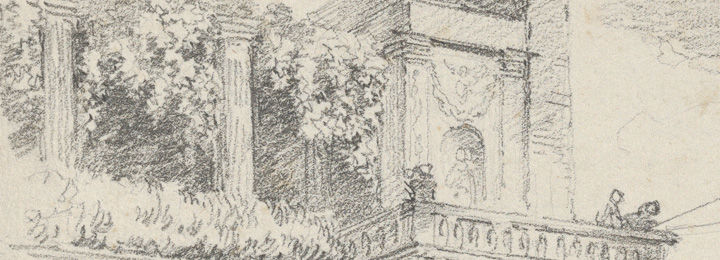
Born in Grasse, a perfume capital in the south of France, Fragonard grew up in Paris from age six. He received his early training in the busy studio of Rococo painter François Boucher, followed by more formal instruction at the official school of the Académie Royale.
The next stage in the crown-sponsored training of promising young history painters was study at the Académie de France in Rome. Fragonard's stay there, which began in 1756, was initially marked by a crisis in confidence, as he felt overwhelmed by the great masters of the Renaissance. He found his footing by turning instead to the Baroque artists with whom he felt a greater affinity and to the Italian landscape, where the Académie's director, Charles Joseph Natoire, led students on sketching expeditions.
Critical also for Fragonard's career was the friendship he forged in Rome with the collector and amateur printmaker Jean Claude Richard, the abbé de Saint-Non. The two men spent the summer of 1760 in Tivoli before returning to France together in 1761. On their unhurried journey home, they meandered through Italy for five months, visiting churches and palaces, while Fragonard made hundreds of sketches.
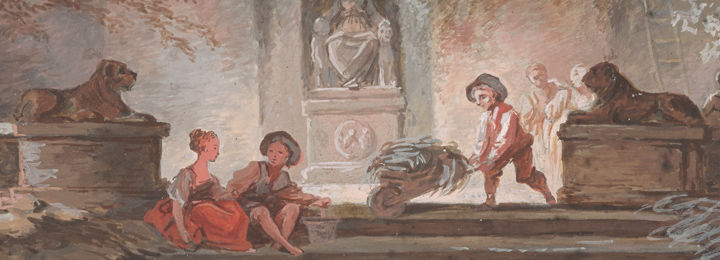
There is little data to document Fragonard's activities in the years directly following his return from Italy in 1761, but it is clear that he began to deviate from the expected path of a history painter. Coresus and Callirhoë, the grand canvas he submitted as his acceptance piece—the first step in gaining admission to the Académie Royale—was greeted with unanimous acclaim in 1765, but he never completed the reception piece that would have qualified him for full membership.
Instead, Fragonard chose to devote his energies to a more varied range of subject matter intended to appeal to private clients. During these years, drawing appears to have been his preferred medium. Landscapes predominate, worked in an impressive range of styles and incorporating the observation of nature, his memories of Italy, and a growing fascination with Holland. Seen from a modern perspective, Fragonard's decision to forge a career apart from the institutions of the court, the church, and the academy was an assertion of artistic freedom and autonomy.
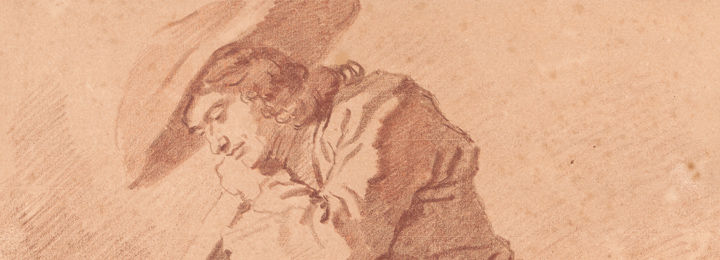
Fragonard had the good fortune to visit Italy a second time, in 1773–74, 12 years after his first stay in Rome. The collector and financier Pierre Jacques Onésyme Bergeret de Grancourt organized the yearlong voyage. Their itinerary took them first to Nègrepelisse, a town north of Toulouse where Bergeret had recently inherited a château. They spent six months in Rome and Naples before beginning a two-month return journey, passing through Bologna and Venice and then looping eastward to take in the treasures of Vienna, Prague, Dresden, and Frankfurt.
Although Fragonard's second journey was superficially parallel to his first, his artistic experience was markedly different. Reinvigorated by the renewed exposure to Italy and unencumbered by financial pressure, he turned his gaze to all that appealed to him in the labor and leisure that made up everyday life on the Italian peninsula. He made quick and sharply observed portraits of his companions and friends as well as of colorful figures from the streets: entertainers, vendors, and fishermen.
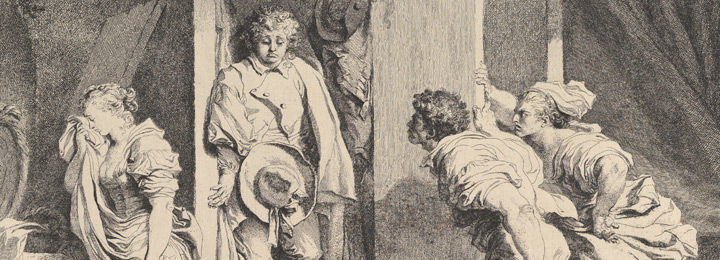
Fragonard made etchings during three brief and defined periods over the course of his career. His first foray, during his time as a student in Boucher's studio, resulted in a single print based on a drawing by his master. Fragonard's friendship and collaboration with the abbé de Saint-Non provided the context for a second period of activity. In 1763–64, shortly after their return from Italy, he produced a group of 21 small and exquisite etchings after his own drawings, many of them copies of Italian paintings, as well as a handful of others more loosely inspired by the gardens and antiquities of Italy.
The artist's third etching campaign yielded his largest and most ambitious plates. The last four prints, all dating to 1778, are again the product of a teaching relationship: this time Fragonard was the master and Marguerite Gérard, his sister-in-law, was the student. Picking up the etching needle to demonstrate the technique to his teenage pupil, he must have found himself newly energized by its possibilities. The project's crowning work—The Armoire, a dramatic scene of angry parents interrupting their daughter's tryst—is one of the great achievements of printmaking in 18th-century France.
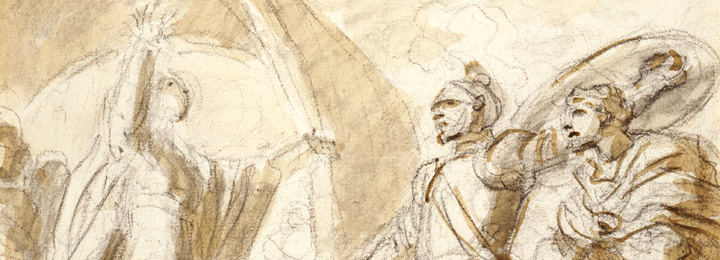
Illustrations of literary texts make up a significant portion of Fragonard's graphic oeuvre. Curiously, few of the projects he undertook were ever published. This raises the possibility that his virtuoso conjuring of compositions from fictional tales was done not on commission from a publisher but as an end in itself.
Over the course of three decades, Fragonard drew illustrations based on a great diversity of works, from the salacious and lighthearted 17th-century Tales of Jean de La Fontaine to the far-fetched romantic adventures chronicled in The Queen of Golconda (1761) by Stanislas Jean de Boufflers.
The pinnacle of his achievement in this realm are the large and airy illustrations—at least 179—he drew for Orlando Furioso in the second half of the 1780s. An epic poem by the Italian Renaissance author Ludovico Ariosto, the story details the romantic and chivalric exploits of two heroes, Orlando and Ruggiero. Their adventures—replete with violence, magic, and lust—unfold against the backdrop of a religious war between the Christian emperor Charlemagne and a fictional Saracen king, Agramante.
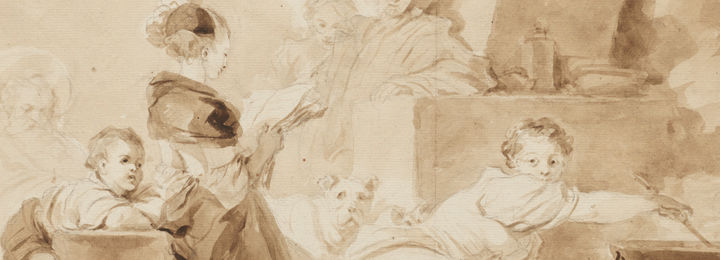
Fragonard continued to draw and paint following his return in 1774 from his second Italian voyage, but his output progressively slowed, and after the Revolution his activities shifted to museum administration. His late drawings can be stubbornly resistant to precise dating and interpretation, but his favored subjects recur again and again. Italy, in particular, loomed large in his imagination, its motifs indelibly absorbed into his personal repertoire.
Well into the 1780s, Fragonard's landscapes continued to feature towering cypresses, weathered stone stairs, parasol pines, and overgrown fountains, as if depicting a recurring dream set in a nonspecific, but clearly Italianate, garden. The universal joys of family life were also a frequent theme during this period, when Fragonard was increasingly occupied with his own family. The settings can be rustic or elevated, but, like his landscapes, there is a fluidity between the real and the imaginary. Some reflect the day-to-day life of his family and social circle, while others evoke a timeless ideal.
Banner image: Jean Honoré Fragonard (French, 1732–1806). Rinaldo in the Enchanted Forest (detail), ca. 1763. Brown wash over very light black chalk underdrawing, 13 3/16 x 18 in. (33.5 x 45.7 cm). The Metropolitan Museum of Art, New York, Purchase, Louis V. Bell, Harris Brisbane Dick, Fletcher, and Rogers Funds and Joseph Pulitzer Bequest; Guy Wildenstein Gift; The Elisha Whittelsey Collection, The Elisha Whittelsey Fund; Kristin Gary Fine Art Gift; and funds from various donors, 2009 (2009.236). Blog series image: Jean Honoré Fragonard (French, 1732–1806). The Island of Love (detail), ca. 1770-80. Black chalk and gouache, 11 x 14 1/4 in. (27.9 x 36.2 cm). Private collection